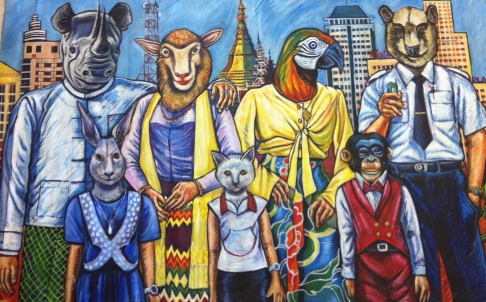
Paintings censored by Myanmar’s brutal military junta will soon appear in Hong Kong. The works span the past six decades, during which all facets of artistic life and expression in the country were controlled by Myanmar’s oppressive regime. Fifty examples of these banned works are featured in two separate venues in Hong Kong, through the end of November.
On view at the Nock Art Foundation (October 22–November 9) and the Hong Kong Visual Arts Centre (November 29–December 1), “Banned in Burma: Painting Under Censorship” includes a variety of themes and styles, which were either banned outright, forcibly removed from public display, or heavily censored by the government beginning in 1962.
The exhibition’s co-curators Ian Holliday and Melissa Carlson see the show as a gateway for Burmese artists to gain exposure after decades of censorship and political repression kept their lives and their artwork largely in the dark.
“A lot of the work was kept hidden in studios for years,” Carlson, a graduate student at Johns Hopkins University’s School of Advanced International Studies (SAIS), told the South China Morning Post. “It’s a fascinating collection that really reflects the imprint of more than 50 years of the military regime’s fears, paranoia and nationalistic aspirations. It gives us a sense of the challenges faced by artists who experimented with non-traditional art forms.”
The range of dates on the pieces gives some insight into how, over the course of 50-plus years, very little has changed for artists in Myanmar in terms of artistic rights and freedom of expression.
One painting, the oldest in the show, dated 1962 (the year the Junta took power) features a self-portrait of the artist, Maung Theid Dhi, that originally showed a figure bound in chains and removed by censors in 1974. Two years later, the artist showed the work under a different title, depicting the figure in leather, more chains, and antlers—an act which instigated Dhi’s 10-day imprisonment.
Two more paintings, by artist Sandar Khine, banned as recently as last year, display prominently the use of blood red, a color popular among other Burmese artists which, the show’s curators say, has distinctly political overtones owing to its use by the National League for Democracy (NLD) in their flag.
The show’s timing could not be any more poignant. In a city rocked by protests in recent weeks, Carlson says the exhibition can offer lessons as well as inspiration for the citizens of Hong Kong. “Artists in Burma never stopped asking important questions about the future of their nation.” she told the Post. “We think this is a message that will resonate with Hong Kong people, particularly now.”